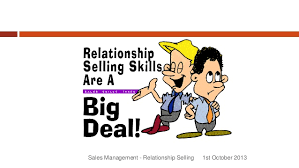Relationship Selling
Relationship selling is – as the name implies – a sales technique based around using client relationships to close sales. It is typically used to sell high-ticket items and things like customizable software – purchases that have a long sales cycle.
Instead of Sales Professionals solely focusing on the pricing of a product or services (or even all the details about the said product or service), the priority is on the interactions and trust built between sales and the customer/buyer.
It is easier to keep an existing customer than secure a new one, and relationships play a key part in helping customer stickability.
One of the main reasons relationship selling exists is to boost salespeople’s personal connection to their customers and clients. Without building a relationship, customers may feel like they are just a number.
How to satisfy a customer
Add value to the product
Quickly gain credibility and establish yourself as a trusted advisor, the very first thing you should do is add value to your prospect’s life. That might mean reaching out with some helpful suggestions, sending them links to relevant content, making a valuable introduction, or anything else that benefits them.
Learn about their situation
Once you have gotten their attention and proved that you are worth their time, dig into their business challenges, objectives, metrics, and qualifying characteristics, along with their personal and professional goals.
Do not force the sale with anyone who is not a good fit. You might be able to convince them to buy, but remember: Relationship selling is about the long term.
Give tailor-made advice
Combine your new knowledge of the client with your subject-matter expertise to deliver your suggestions. For example, you might prescribe a strategy that will address one of their core pain points (and happens to align with your product).
Resolve objections
Take note that relationship selling calls for a careful approach. Give the client ample time to explain themselves, be patient and above all, answer honestly. If they have a genuine reason to be concerned, do not ignore that. Your truthfulness will be more reassuring than a convincing response (and will hold up after they get their hands on the product).
Dig into the prospect’s objection to make sure you fully understand.
Finally, it is time to respond. Do not be combative -- you and your prospect are on the same team.
Find a win-win solution
Many salespeople treat negotiation like a zero-sum game. In other words, if the buyer wins, they lose, and vice versa. This mentality erodes trust and forces your negotiation partner to act selfishly. Plus, if they walk away feeling like you have taken advantage of them, your long-term relationship is shaken.
The solution? Act like a win for your prospect because it is a win for you. Together, you are trying to find the best possible outcome.
Happy Selling!

